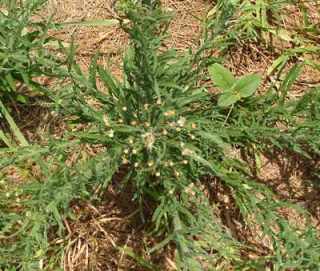Scientific Name
Conyza bonariensis (L.) Cronq.
Synonyms
Conyza ambigua DC., Conyza crispa (Pourret) Rupr., Erigeron bonariensis., Erigeron crispus (Pourret)., Erigeron linifolius wild
Common Names
fleabane, hairy horseweed, flax-leaf fleabane, wavy leaf fleabane, rough conyza, Argentine fleabane
Origin
North America
Family
Asteraceae
Habit
Erect perennial, stem rough branching extensively at the base of the plant with tapered leaves covered in stiff hairs, 20-75 centimetres in height.
Habitat
Widespread weed of cultivated land, garden areas, wasteland and roadsides. Found from spring to autumn, most prevalent in summer months.
General Description
Stems and Leaves:
Erect stems with stiff hairs, branching extensively at the base, decreasing upwards, stems can be 20-75cm in height. Narrow lanceolate leaves are grey to green in colour, measuring 2-6cm in length, coarsely toothed and covered in fine hairs. Upper leaves are smaller and linear.
Flowers and Fruit:
Flowers are numerous on poorly arranged pyramidal panicles (much branched inflorescence). The capitulum (flower head) is greater than 2mm in diameter and looks in fact like a flower bud. Flowers occur at the ends of the branches. Surrounding each flower are involucral (bell-shaped leaf-like) bracts 3-5mm in length, the inside of each bract is white sometimes tinged purple or red. The cypsela (fruit) is a linear shaped seed approximately 1.5mm long, straw coloured, covered in hairs with 16-20 noticeably longer at the top that are white or pink. Flowering is in spring-autumn.
Distinguishing characteristics
Tapered rough leaves covered with stiff hairs. A few bract hairs at apex are longer than the involucre bracts. Branching at base of plant with outside stems taller than the central stem. The top of the flower stalk (receptacle) is smoothly pitted.
Conyza bonariensis can easily be confused with Conyza canadensis and Conyza albida which are also weeds. C. canadensis can be distinguished from C. bonariensis in that unlike C. bonariensis it can grow up to 1.5m high, the involucral bracts (leaf-like structures surrounding the flower head) have a brownish inner surface and the hairs (pappus) of the seed are cream. Conyza albida has bracts of the flower head that are hairy as in C. bonariensis but differ in that there are no long hairs near the apex of the bracts.
Sources & References
Carolin R, Tindale MD (1993) 'Flora of the Sydney region.' (Reed: Chatswood, Australia)
Cunningham GM, Mulham PL, Leigh JH (1981) 'Plants of Western New South Wales.' (NSW Government Printing Office: Australia)
Hanks M, Rose L (2001) 'A growers guide to pests, weeds and diseases.' ( Murdoch Books: Sydney, Australia)
Jessop J (1981) 'Flora of Central Australia.' (AH &AW Reed Pty Ltd: Sydney, Australia)
Kleinschmidt HE, Johnson RW (1987) 'Weeds of Queensland.' (QLD Department of Primary Industries: Brisbane, Australia)
Muenscher WC (1955) 'Weeds.' 2nd edn. (The Macmillan Company: New York,USA)
Pacific island ecosystems at risk (2004) www.hear.org
Prepared by Kylie Pethybridge, 2005
Checked by Carole Campbell, 2005
Updated by Justin KY Chu, July 2005
Checked by Dr Peter Michael, July 2005
